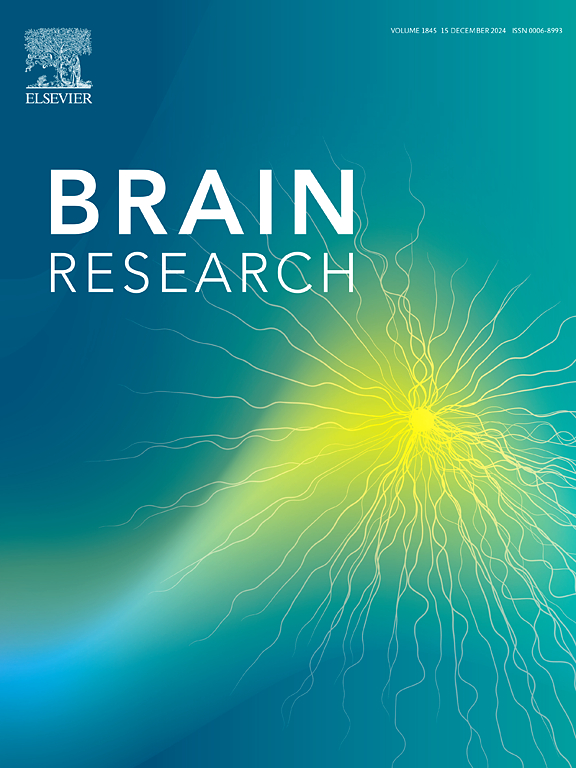3-N-Butylphthalide alleviate Aβ-induced cellular senescence through the CDK2-pRB1-Caspase3 axis
IF 2.7
4区 医学
Q3 NEUROSCIENCES
引用次数: 0
Abstract
Alzheimer’s disease (AD) is a neurodegenerative disorder characterized by the accumulation of amyloid-beta (Aβ) and leading to cellular senescence and cognitive deficits. Cellular senescence contributes significantly to the pathogenesis of AD through the senescence-associated secretory phenotype (SASP), exacerbating Aβ deposition. This study investigates the protective effects of 3-N-Butylphthalide (NBP), a compound derived from Apium graveolens Linn (Chinese celery), on Aβ-induced cellular senescence in U87 cells. Using RNA-sequencing and biochemical assays, we demonstrate that NBP ameliorate Aβ oligomer-induced cellular senescence and apoptosis, and regulated the expression of cyclin-dependent kinase inhibitor 2A (CDKN2A) and components of the cyclin-dependent kinase 2 (CDK2)- phosphorylated retinoblastoma 1 (pRB1)-Caspase3 pathway. Moreover, NBP was shown to suppress the expression of SASP-related genes. These findings suggest that NBP rescues U87 cells from Aβ oligomer-induced senescence and apoptosis through modulating the CDK2-pRB1-Caspase3 axis and SASP expression. Our results underscore the potential of NBP as a senostatic agent for AD which have not been reported in previous studies, offering insights into its mechanisms of action and paving the way for future studies on its efficacy in vivo and in clinical settings. Thus, we contribute to growing evidence supporting the use of senolytic and senostatic agents in the treatment of AD.

3- n -丁苯酞通过CDK2-pRB1-Caspase3轴缓解a β诱导的细胞衰老。
阿尔茨海默病(AD)是一种神经退行性疾病,其特征是淀粉样蛋白- β (a β)的积累,并导致细胞衰老和认知缺陷。细胞衰老通过衰老相关分泌表型(senescence associated secretory phenotype, SASP)加剧了Aβ的沉积,对AD的发病机制起着重要作用。本文研究了从芹菜中提取的化合物3- n -丁基酞(NBP)对a β诱导的U87细胞衰老的保护作用。通过rna测序和生化分析,我们证明NBP改善了Aβ寡聚物诱导的细胞衰老和凋亡,并调节细胞周期蛋白依赖性激酶抑制剂2A (CDKN2A)和细胞周期蛋白依赖性激酶2 (CDK2)-磷酸化视网膜母细胞瘤1 (pRB1)- caspase3通路组分的表达。此外,NBP还能抑制sasp相关基因的表达。这些结果表明,NBP通过调节CDK2-pRB1-Caspase3轴和SASP表达,使U87细胞免于Aβ寡聚物诱导的衰老和凋亡。我们的研究结果强调了NBP作为一种在以前的研究中未被报道过的AD的静感药物的潜力,提供了对其作用机制的见解,并为其在体内和临床环境中的有效性的未来研究铺平了道路。因此,我们提供了越来越多的证据支持使用抗衰老和抗感药物治疗AD。
本文章由计算机程序翻译,如有差异,请以英文原文为准。
求助全文
约1分钟内获得全文
求助全文
来源期刊

Brain Research
医学-神经科学
CiteScore
5.90
自引率
3.40%
发文量
268
审稿时长
47 days
期刊介绍:
An international multidisciplinary journal devoted to fundamental research in the brain sciences.
Brain Research publishes papers reporting interdisciplinary investigations of nervous system structure and function that are of general interest to the international community of neuroscientists. As is evident from the journals name, its scope is broad, ranging from cellular and molecular studies through systems neuroscience, cognition and disease. Invited reviews are also published; suggestions for and inquiries about potential reviews are welcomed.
With the appearance of the final issue of the 2011 subscription, Vol. 67/1-2 (24 June 2011), Brain Research Reviews has ceased publication as a distinct journal separate from Brain Research. Review articles accepted for Brain Research are now published in that journal.
 求助内容:
求助内容: 应助结果提醒方式:
应助结果提醒方式:


